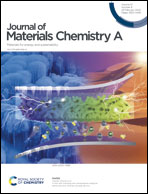A modeling study of PEM fuel cells with novel catalyst monolayers under low platinum loading
Abstract
Cost is a major barrier for commercialization of polymer electrolyte membrane (PEM) fuel cells. Catalyst layers (CLs) contribute to a major portion of the PEM fuel cell cost due to the use of platinum (Pt) group metal catalysts. To reduce Pt loading, a novel photo-driven method was recently proposed to fabricate CLs with low Pt loading through the photocatalytic nucleation and growth of dendritic Pt spherical-nanocrowns on a PEM in a solution with aqueous Pt complexes. The method produces catalyst monolayers with a thickness around 60 nm and a Pt loading of 0.09 mg cm−2 (the cathodic and anodic loadings of 53.3 and 37.2 μg cm−2, respectively), which exhibit a power output exceeding 1.0 W cm−2 in single cell testing. In this study, we carry out a three-dimensional (3D) modeling study to investigate the reaction rate and oxygen and liquid water distribution in PEM fuel cells with CLs. The model predictions are compared favorably with the experimental data in terms of the polarization curves. It is shown that the CLs have a low effective exchange current density due to the low electrochemical surface area (ECSA). The cathode CL under the land is subjected to low oxygen content operation at low voltages, which leads to a large in-plane variation of the oxygen reduction reaction (ORR) rate. The variation is more severe for operation with the air cathode reactant flow than with oxygen. Additionally, the through-plane ORR variations are found to be much smaller than the in-plane ones due to the thin CL thickness. To further improve the performance of the novel CLs under low Pt loading, the ECSA and the GDL oxygen diffusivity need to be considerably increased.



 Please wait while we load your content...
Please wait while we load your content...